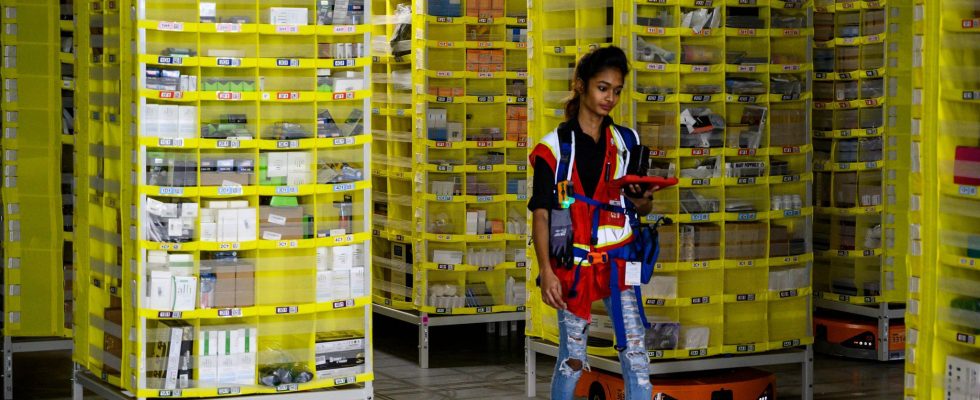Jeff Bezos’ firm continues to seek to increase its already significant market share. On Wednesday October 18, Amazon presented new robots for its warehouses and new drones for air delivery. These tools are in addition to the 750,000 robots already installed in its warehouses for ten years.
A development strategy using technology intended to allow the online commerce giant to further accelerate the pace of its deliveries and keep up with its competitors. At the risk of worsening the working conditions of its employees.
Robots and drones that do not replace humans, according to the firm
One of Amazon’s main announcements concerns the development of its trump card: delivery by aerial drone in less than an hour, called “Prime Air”, already present in two American cities, in Texas and California. The multinational announced on Wednesday its desire to expand this service to three new areas: in Italy, in the United Kingdom, and on a third undisclosed American site, by the end of 2024.
The company also revealed the commissioning of a new type of drone, more resistant, and specified that its Texan customers could soon have prescription drugs delivered by air, indicates the American online media The Verge.
The multinational is also trying to optimize its upstream delivery process: Amazon has announced the launch of a new robotics system called “Sequoia”, supposed to speed up the preparation and distribution of packages. Order processing time reduced by 25% in the best scenarios, according to the company. The second largest employer in the United States will also test android robots from the start-up Agility Robotics to carry plastic bins in place of employees.
A new wave of automation of its activities which nevertheless does not aim to replace human work, according to Amazon’s vice-president in charge of the robotics branch, who judges that these systems “allow us to spare people who have to wear heavy things or walking miles [et que] “Humans are still good at certain tasks that robots will not be able to perform.”
According to a company press release, current robotics systems have created “hundreds of thousands of jobs” over the past ten years. If these figures are unverifiable, several studies cited by the British daily the Guardian nevertheless seem to show that technological innovations in warehouses would present “little risk of leading to significant job losses”.
A frantic race to keep up with its competitors
A bet of delivery by drones and investment in robots that is worth it, according to the director of engineering for Prime Air, Jason Patrao: “Our customers have always wanted more speed, he declared in an interview during Amazon’s annual marketing event. With drones, we can deliver in thirty minutes on a large scale.”
Behind this objective of ever greater speed, Amazon seeks to follow and catch up with the pace of its competitors. Faced with other e-commerce services first: despite its essential appearance, Amazon has had to fight for a year against the arrival in the United States of the Chinese application Temu, which offers products cheaper than those of the giant American, tells CNBC.
Above all, Amazon is seeking to take more and more space in the face of physical stores: “In-person sales […] still represent more than 80% of total retail sales, in particular because the transaction is immediate”, recalls analyst Andrew Lipsman to AFP. Amazon therefore has every interest in speeding up its deliveries, in order to facilitate the choice of the buying online rather than the alternative of physical stores.
A pace not without consequences for employees
If this logic is beneficial for the multinational’s market share, it is also the source of problems at work for its employees. For Sheheryar Kaoosji, director of the Warehouse Worker Resource Center, a support organization for warehouse workers, Amazon will continue to have “one of the highest workplace injury rates in the country” as long as it imposes productivity levels too high.
A statement that echoes recent news from Amazon in France. Saturday October 14, a study by the independent firm Progexa commissioned by Amazon’s central social and economic committee (CSE) revealed that the number of work accidents resulting in lost time had more than doubled in 2022: on nine company sites in France, it noted 1,132 incidents, compared to 482 the previous year.
An increase explained by managerial “pressures” and “results imperatives”, according to employees interviewed by AFP. In the event of an injury, many denounce a “blame” strategy. After blocking her back, Hélène says that her superiors told her that “it was [sa] mistake”.
If Amazon France defended itself by claiming to offer “a safe and modern working environment” to its 20,000 employees, the Progexa report notes that 90% of them have less than five years of seniority. The firm’s growth in France therefore seems to come at the cost of rapid renewal of its workforce, a quarter of which ended up resigning in 2022.
